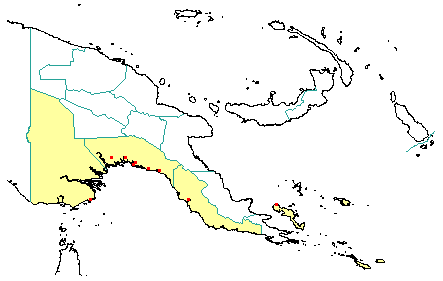
in PNGplants database
PNGTrees – Avicennia officinalis L. |
Barry Conn (NSW) & Kipiro Damas (LAE).
Copyright held by the authors, Royal Botanic Gardens and Domain Trust, and Papua New Guinea National Herbarium
Species Plantarum Vol. 2: 110 (1753)
Other Literature: N.C. Duke, Australian Systematic Botany Vol. 4: 319-321 (1991) Fig. 10.
Field Characters: Small trees often 5-10 m high, or a shrub or large trees up to 25 m high. Bole cylindrical up to 25 cm diam.; straight bole 7 m long; buttresses absent; spines absent; aerial roots absent or present low-placed aerial roots common; stilt roots absent pneumatophores 20-30 cm high. Bark yellow, green, grey, or brown, slightly rough or smooth in young trees, scattered pustular older trees or finely fissured; lenticels irregular; subrhytidome red or brown; bark thickness <25 mm thick, 3.0-5.0 mm thick; blaze consisting of one layer; faintly to non-aromatic or strongly aromatic; pleasant; outer blaze white or pale yellow, markings absent, fibrous; inner blaze white or pale yellow, markings absent, fibrous; exudate present or absent, colourless, spotty, changing colour on exposure to air, to dark grey, not sticky. Terminal buds not enclosed by leaves; complex hairs absent; stinging hairs absent; mature twig without hairs or mature twig hairy; hairs sparse or hairs dense.
Leaves: Spaced along branches <internodes readily visible>. Leaves opposite, simple; petiole present 8-13(-17) mm long, not winged, attached to base of leaf blade <not peltate>, not swollen; lamina sometimes broadest above middle or broadest at or near middle, 4.0-9.0 (-12.5) cm long, 2.0-4.0 (-6.0) cm wide; lamina symmetric, margin entire, not dissected or lobed, apex rounded or obtuse, venation pinnate <secondary veins arising from the midrib along its length>, secondary veins open <spaced far apart to easily see tertiary veins>, not prominent, but visible, intramarginal veins absent; lower surface pale green or greenish grey, upper surface dark green or glossy green shiny, hairs present, sparse sparsely pubescent on lower surface; oil dots absent; domatia absent; stipules absent.
Flowers: Inflorescence terminal <at branch ends>. Flowers on a branched axis with 2-12 flowers congested into a compact cluster; flowers bisexual, not stalked, slightly asymmetric corolla variously zygomorphic or with many planes of symmetry <actinomorphic>, 8.0-12.0 mm long, small (< or =10 mm diam.) 5-12 mm diam.; perianth present, with distinct sepals and petals, yellow or orange; inner perianth 4, some or partly joined lobes 3-5 mm long; stamens 4 (of different lengths), filaments present about 3 mm long, free of each other, joined to perianth <epipetalous/episepalous> ovary superior <seated above petals and sepals; hypogenous>, carpels joined (when more than one) <syncarpous>, locules 1; styles solitary <including joined together>, 1 (short).
Fruits: Fruits arranged on branched axis. Fruit 12-18 (-27) mm long, 8.0-15.0 mm diam., fruit pale grey, pale yellow, or pale green, not spiny velvety hairy, non-fleshy, simple, dehiscent, capsule. Seeds 1, not winged, as wide as long.
Distribution: Western, Papuan Islands, Gulf & Central.
 | Botanical records in PNGplants database |
Notes: The seedlings (radical) of this species are about 13 mm long, densely hairy throughout with hairs straight or wavy.
Previously placed in the Verbenaceae and more recently in its own family, the Avicenniaceae.